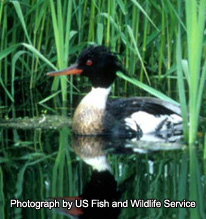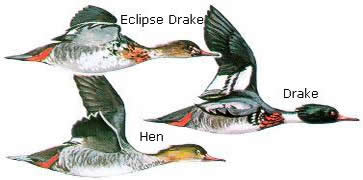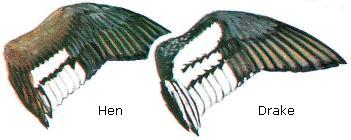Wildlife - Species

Species Specific Regulations
Red-Breasted Merganser
Licenses: Hunting License required. Migratory Bird Hunting and Conservation Stamp (Federal Duck Stamp) that is validated by the hunter signing the stamp in ink across the face of the stamp
Limits: Please see Migratory Bird Regulations for any game zones restrictions or Limitations.
Red-Breasted Merganser (Mergus serrator )

Description
Red-breasted mergansers are large diving ducks with a long, thin reddish orange bill and an iridescent green head.
Average Size
Red-breasted mergansers have an average length of 23 inches and an average weight of 2 1/2 pounds.
Range
These birds are most abundant in the northern Atlantic flyway, but can be found in all 4 flyways. They overwinter along the South Carolina coastline.
Preferred Habitat
Red-breasted mergansers spend the summer on fresh, brackish, and saltwater wetlands of the tundra and boreal zones. In the winter these mergansers can be found on secluded bays and estuaries in saltwater environments along the both coasts.
Typical Flock Pattern

Wings

Food Habits
The main food consumed by mergansers is small fish and crustaceans. They will also eat worms, insects, and amphibians in smaller amounts.
Reproduction
Pair formation begins in late winter and these late breeders do not begin nesting until late May. The female selects the nest site on the ground near water, usually under shelter or in dense cover. The initial nest is just a scrape, but throughout the nesting period dead grass and litter is added to the nest. The average nest size is around 10 olive buff eggs.
Sound
Drake makes a catlike yeow-yeow, and hens produce a raspy krrrr-krrrr call.
Behavior
- Their flight, strong and direct, is usually low over the water.
- Males are not territorial during the nesting season but protect their mates and nest sites; may nest colonial with same species and with gulls and terns.
- Social throughout the year.
Publications and Literature
U.S. Fish & Wildlife Service, Federal Duck Stamp Office Presents: North American Waterfowl
Titman, Rodger D. 1999. Red-breasted Merganser (Mergus serrator), The Birds of North America Online (A. Poole, Ed.). Ithaca: Cornell Lab of Ornithology; Retrieved from the Birds of North America Online
South Carolina waterfowl hunters 16 and older are required by state law to obtain a state migratory waterfowl permit and Migratory Game Bird permit. Both permits must be in the hunter's possession while hunting or transporting legal waterfowl. A state waterfowl permit is included with the Lifetime Senior, Lifetime Gratis and Disability Licenses. S.C. residents who hold a Lifetime Senior or Lifetime Gratis License are not required to have a Migratory Game Bird permit.
National Migratory Bird Harvest Information Program (HIP)
The waterfowl permits and HIP permits are available from select DNR offices and from hunting and fishing license agents.
